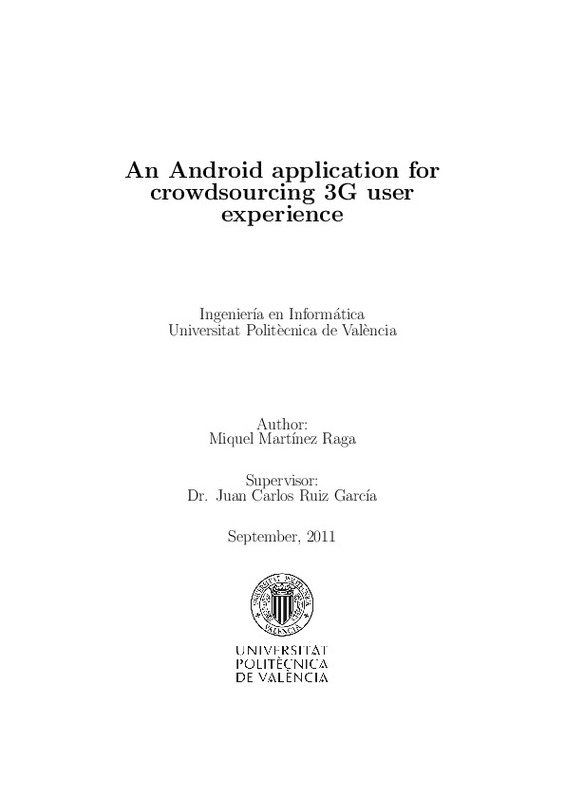JavaScript is disabled for your browser. Some features of this site may not work without it.
Buscar en RiuNet
Listar
Mi cuenta
Estadísticas
Ayuda RiuNet
Admin. UPV
An Android application for crowdsourcing 3G user experience
Mostrar el registro sencillo del ítem
Ficheros en el ítem
| dc.contributor.advisor | Ruiz García, Juan Carlos
|
es_ES |
| dc.contributor.author | Martínez Raga, Miquel
|
es_ES |
| dc.date.accessioned | 2011-10-11T08:31:08Z | |
| dc.date.available | 2011-10-11T08:31:08Z | |
| dc.date.created | 2011-09-30 | |
| dc.date.issued | 2011-10-11 | |
| dc.identifier.uri | http://hdl.handle.net/10251/11987 | |
| dc.description.abstract | This report is composed by a project splited in two parts, a practical part and a research one. The first part of the project was done in Valencia (Spain) under the supervision of the company NUBESIS. We developed an Android application that is the mobile application for a website developed by the same company. We describe the problems we had while developing the application and the way we solved them. We will explain the diferent processes that take place in the application and how these processes are integrated in the application's functionality, we also talk about the user's interaction with the diferent screens and their behavior. The second part of the project is planned as a research project to improve the connectivity problem that can appear in the firrst application. This part was done in Sydney (Australia) in cooperation with the University of New South Wales (UNSW) and under the supervision of professor Mahbub Hassan. In this part we discuss the design and implementation of Android based 3G/HSDPA network bandwidth measurement mobile application. This application acts as a mobile sensor in a crowd sourcing system. We use a network link bandwidth estimation technique called packet pair probing, which can easily be implemented on a mobile platform and we also justify why we have chose the specific methodology after reviewing the related literature. We also propose a measurement initiation process with theMeasurement Server which allows the packet pair probing technique to reect an accurate download bandwidth on the measurement. We have calibrated and netune the measurement tool so it can contribute optimally to the crowd sourcing system by addressing issues such as usability, data consumption and power consumption. We include geo tags in each measurement we take and discuss the implementation issues addressed in the project. Finally, we introduce an algorithm which measures the download bandwidth in a timely fashion. We study the behaviour of the measurements by changing parameters such as packet size and packet train length. The results obtained were evaluated by comparing them to a reliable commercial bandwidth estimation tool under the same environment. Given these results we conducted a number of hypothesis tests where we used the T-statistic as the test statistic under the null hypothesis. | es_ES |
| dc.format.extent | 88 | es_ES |
| dc.language | Inglés | es_ES |
| dc.publisher | Universitat Politècnica de València | es_ES |
| dc.rights | Reconocimiento - No comercial - Sin obra derivada (by-nc-nd) | es_ES |
| dc.subject.classification | ARQUITECTURA Y TECNOLOGIA DE COMPUTADORES | es_ES |
| dc.subject.other | Ingeniería Informática-Enginyeria Informàtica | es_ES |
| dc.title | An Android application for crowdsourcing 3G user experience | es_ES |
| dc.type | Proyecto/Trabajo fin de carrera/grado | es_ES |
| dc.rights.accessRights | Abierto | es_ES |
| dc.contributor.affiliation | Universitat Politècnica de València. Escola Tècnica Superior d'Enginyeria Informàtica | es_ES |
| dc.description.bibliographicCitation | Martínez Raga, M. (2011). An Android application for crowdsourcing 3G user experience. http://hdl.handle.net/10251/11987. | es_ES |
| dc.description.accrualMethod | Archivo delegado | es_ES |
Este ítem aparece en la(s) siguiente(s) colección(ones)
-
ETSINF - Trabajos académicos [5160]
Escola Tècnica Superior d'Enginyeria Informàtica






